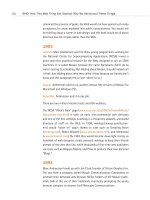Taking Your Talent to the Web- P2 ppsx
Bạn đang xem bản rút gọn của tài liệu. Xem và tải ngay bản đầy đủ của tài liệu tại đây (159.94 KB, 15 trang )
Dedication
To Joan, whose love makes me feel happy and safe.
To my Dad, who taught me to be independent.
To my Mom, who loved books. I wish she could have seen this one.
xvi
00 0732 FM 4/24/01 1:38 PM Page xvi
Acknowledgments
I cannot possibly name all the people whose creativity has inspired me, or those I’ve been lucky enough
to collaborate with over the years. It would take hundreds of pages to properly thank those I’ve worked
with this year alone.
In childhood, I attended a wedding where the bride and groom thanked the special people in their lives.
In the flush of the moment, they forgot to name one friend. He harbored a resentment that deepened
over the years. Ultimately, a tragedy ensued, in which innocent bystanders lost their lives. But I digress.
Rather than make a similar mistake, I’m going to deliberately omit the names of many special people
who contributed to my knowledge of the Web and thus, however unwittingly, to this book. Even if you
are not named below, I love you and am grateful to you, and you should buy this book regardless.
To Steve Crozier of Populi, who envisioned an intelligent method of teaching web design, and to Mar-
garet Alston and Cheryl Stockton, who collaborated with me on the development of the Populi Cur-
riculum, my sincere and endless thanks.
My deep gratitude to Michael Nolan for asking me to write this book. To Michael and Karen White-
house for shepherding it safely through the minefields of the publishing industry. To development ed-
itor Victoria Elzey for keeping it real. And to my friend and this book’s technical editor Steven Cham-
peon for finding all the mistakes and not telling anyone but me.
To my beloved friends Fred Gates, Leigh and TJ Baker-Foley, and Katherine Sullivan: thank you for shar-
ing your lives, keeping me sane, and forgiving the disappearances, hibernation, and mood swings that
accompanied the writing of this book.
To Jim, who asked only an occasional phone call and got nothing but months of silence: I wrote this
book for you, I owe you more than these words express, and I promise to start calling again, really.
To Don Buckley, my friend and first web client, and to my first web design partners, Steve McCarron
and Alec Pollak, sincere thanks and respect.
All web designers owe thanks to Glenn Davis for contributions too numerous to describe here. Simi-
larly, respect and thanks to George Olsen, Teresa Martin, and Michael Sweeney. You know what you
did.
Love, thanks, and respect to Brian M. Platz, co-founder of A List Apart back when it was a mailing list
for web designers. To Bruce Livingstone, Nick Finck, Webchick, and Erin Kissane, who help keep ALA go-
ing. And to the fine writers who make it worth reading, including Joe Clark, J. David Eisenberg, Curt
xvii
00 0732 FM 4/24/01 1:38 PM Page xvii
Cloninger, Alan Herrell, Scott Kramer, Jeffrey Veen, John Allsopp, Robin Miller, Denice Warren, Jason
Kottke, Lance Arthur, Glenn Davis, Alyce McPartland, Ryan Holsten, Julia Hayden, Peter-Paul Koch,
Wayne Bremser, D.K. Robinson, L. Michelle Johnson, Mattias Konradsson, Steven Champeon (again),
Chris Schmitt, Marlene Bruce, Lee Moyer, Bob Stein, Dave Linabury, Mark Newhouse, Bob Jacobson, Eri-
ka Meyer, Ross Olson, Rich Robinson, Bill Humphries, Scott Cohen, Peter Balogh, Robert Miller,
Shoshannah L. Forbes, Pär Almqvist, Simon St. Laurent, Jennifer Lindner, Nick Finck (again), Jim Byrne,
Makiko Itoh, Ben Henick, George Olsen (again), and Chris MacGregor.
Thanks to everyone who’s ever looked at any site I’ve had a hand in creating, and especially to those
who’ve written (even if you wrote to say it stank). Thanks to all the web designers and developers who
joined The Web Standards Project.
Hello? Thanks to Tim Berners-Lee for inventing the Web. Thanks to the Web’s first teachers: Jeffrey Veen
(again), Glenn Davis (again), Dan Shafer, David Siegel, and Lynda Weinman. Thanks to Jim Heid and
Steve Broback of Thunder Lizard for support, encouragement, great programs, and fine hotel accom-
modations.
Thanks to Michael Schmidt and Toke Nygaard for the secret work you did on this book, for the incred-
ible work you do on the Web, and for your friendship. Similar thanks to the incredible Carlos Segura.
Thanks to Todd Fahrner and Tantek Çelik for contributing to my knowledge and (more importantly) to
the sane advancement of the Web. Likewise, each in their own way: Tim Bray, Steven Champeon (again),
Rachel Cox, B.K. DeLong, Sally Khudairi, Tom Negrino, Dori Smith, Simon St. Laurent, Eric Meyer, Eric
Costello, J. David Eisenberg (again), Dave Winer, Stewart Butterfield, Carl Malamud, Joe Jenett, Evan
Williams, Robert Scoble, and Peter-Paul Koch (again).
Huge shout-outs to my supremely talented web designer pals. I value your friendship and love your
work. You know who you are, and if you didn’t know you might get a clue from the fact that I am al-
ways linking to you or referring obliquely to you, and if that’s not enough, you’ll find yourselves in the
Exit Gallery at zeldman.com.
The paragraph above and the one you’re now reading constitute the toughest part of writing this book.
In the six years I’ve spent designing websites, I’ve met or corresponded with tens of thousands of tal-
ented people, worked with or gotten close to hundreds. I can’t list you all. This is so painful I feel like
canceling the book, but my publisher insists otherwise. Please accept these tragically empty paragraphs
as my attempt to embrace you all in love and gratitude.
Love and thanks to Peyo Almqvist, Derek Powazek, Josh Davis, Heather Champ, Daniel Bogan, Craig
Hockenberry, Lance Arthur, Michael Cina, Heather Hesketh, Dave Linabury, Dan Licht, Brian Alvey, Shau-
na Wright, Halcyon, Hasan, Matt, Jason, Big Dave, Lmichelle, Fish Sauce, Toke, Michael, Leigh, and
Uncle Joe.
xviii
00 0732 FM 4/24/01 1:38 PM Page xviii
Foreword
I wrote this book for four people:
For Jim, a print designer who’s tired of sending his clients to someone else when they need a website.
For Sandi, a gifted art director, who’s hit a wall in her advertising career, and is eager to move into full-
time interactive design.
For Billy, whose spare-time personal site has gotten so good, he’d like to become a professional web
designer—but is unsure about what is expected or how to proceed.
And for Caroline, a professional web designer who wants to better understand how the medium works
and where it is going.
I did not make up these names or descriptions: These are real people. I knew the book was finished
when it had covered everything they needed to know.
An entire curriculum, a year of work and thought, and 100 years of professional experience (mine, my
editors’, and my collaborators’) have gone into this book.
Enjoy.
Jeffrey Zeldman
1 April 2001
New York City
xix
00 0732 FM 4/24/01 1:38 PM Page xix
Web vs. Print: A Note About URLs
The Web is an ever-changing flow of ideas, designs, and redesigns. Sites evolve and decay. Some move
to new locations. Others disappear. By the time you read this book, some of the sites it describes will
surely have changed, while others may have vanished altogether.
This flow and flux is natural to the Web, and in some ways it is even healthy. It’s good when mediocre
sites improve, and it’s inevitable that pointless sites (like pointless products) eventually fade away.
But healthy and natural or not, the medium’s constant dynamism can wreak havoc with books about
the Web, and thus with those books’ readers. You read about an interesting design or technological de-
cision, fire up your web browser, and discover that the site no longer demonstrates what was discussed
in the book.
Fortunately, dear reader, you can minimize the damage by bearing these things in mind:
1. Most of the concepts and techniques discussed here are fairly widespread. If Site A no longer
sports a nifty rollover technique we’ve described, you’ll probably find it at Site B or Site C. The
principles are more important than the specific examples.
2. Sites should not arbitrarily change page locations, but unfortunately, many do. If a particular web
page seems to have disappeared, try factoring the URL to a simpler version. For instance, if
www.yahoo.com/games/thrills/ no longer works, go back to its purest form, www.yahoo.com/,
and see if you can navigate to the page’s new location that way.
3. Finally, if a site we’ve hailed as an example of creative excellence or touted as a superb resource
for further learning seems to have disappeared, try visiting the zeldman.com Exit Gallery at
www.zeldman.com/exit.html. If the site is truly special and has moved to a new location on the
Web, you’ll find that new address in our Exit Gallery. If the site has actually changed its name,
we’ll mention the former name to help you get your bearings.
Now go forth, design, and conquer.
xx
00 0732 FM 4/24/01 1:38 PM Page xx
Introduction
WHEN WE FIRST MET STEVE CROZIER, president of Populi, we liked what he had
to say.
He said, “I want to buy you lunch.”
When he told us his company’s vision, we liked that even more.
It was a simple solution to a complex problem. On one side, thousands of
designers and art directors are eager to take their talents to the Web but
aren’t sure how. On the other, web agencies could not find enough good
web designers to get their work done.
The Populi program was designed to close the web talent gap by training
traditional designers in the ways of the Web. Until ithe Populi program
comes to your town, this little book can teach you what you need to know.
This is not one of your “Learn HTML in 24 Hours” books, nor is it one of the
many introductory books on web graphics. It won’t teach you how to imi-
tate the stylistic tricks of famous web designers, turn ugly typography into
ugly 3-D typography, or build online shopping carts by bouncing databases
from one cryptic programming environment to another. This is a book for
working designers who seek to understand the Web as a medium and learn
how they can move to a career in web design. It’s also suited to designers
who wish to add web design to their repertoire of client services.
01 0732 Intro 4/24/01 11:12 AM Page 1
Why did we base this book on the Populi curriculum? For one thing, it’s one
of the only programs we know that actually works. For another, we wrote
the curriculum. (To be honest, we wrote the curriculum in cooperation with
courseware developer Margaret Alston, and designer-instructor Cheryl
Stockton, of the Pratt Institute. The cranky opinions are ours; the thor-
oughness and good sense—theirs.)
The concepts contained in the Populi curriculum and this book have been
field-tested on working designers. They’ve been reviewed by web agency
consultants and Pratt faculty members, spoken aloud to tens of thousands
of web conference attendees, rolled in flour, and slow-baked at 450
degrees.
This book will teach you how web design compares to and differs from the
job you know and love. It will explain the medium’s challenges, such as
bandwidth, navigation, and browser compatibility. And it will teach you
enough of the technical details to work with your peers on the production
end and to pinch-hit as needed.
The Populi Curriculum in Web Communication Design, created in coopera-
tion with Pratt Institute, was launched in Dallas in 2000 and will eventu-
ally come to your town.
On the other hand, the book you are holding is available now, at a modest
price.
You know what to do.
2
Introduction
Populi (www.populi.com),
the Web Talent Incubator,
turns traditional designers
and programmers into web
builders.
01 0732 Intro 4/24/01 11:12 AM Page 2
Part I
WHY: Understanding the Web
1 Splash Screen 5
2 Designing for the Medium 13
3 Where Am I? Navigation & Interface 69
02 0732 Part I 4/24/01 11:13 AM Page 3
02 0732 Part I 4/24/01 11:13 AM Page 4
chapter 1
Splash Screen
WHAT DO DESIGNERS DO? Designers organize information, shape identities,
and create memorable experiences that entertain while communicating.
Increasingly, designers are performing these tasks on the World Wide Web
(the Web, to its friends). If you’ve picked up this book, you’re either doing
the work already, thinking of migrating to the field, or considering adding
web design to your repertoire of existing services.
Whether you design websites full-time or just occasionally, you’ll be help-
ing to shape what may be the most inherently profound medium since the
printing press. The Web is vast, intrinsically democratic, and dripping with
creative, personal, and business potential. Oddly enough, for something
that gets used and talked about every day by hundreds of millions, it is also
quite often misunderstood by practitioners as well as users.
Before you do anything drastic, such as buying “web software,” changing
your career, or leaving that louse who is only pretending to love you, it
makes sense to find out where you are going and what you will be dealing
with. So let’s start by examining what the Web is—exactly.
03 0732 CH01 4/24/01 11:14 AM Page 5
MEET THE MEDIUM
The Web is a part of the Internet, a group of interconnected computer net-
works that spans the globe. Web servers deliver content of many kinds,
much of it connected to other content via hyperlinks and therefore
referred to as hypertext. Most of these documents are written in a simple
markup language called HTML, about which we will have much more to
say. But web servers aren’t limited to publishing HTML documents; they can
deliver almost any digital content you care to envision.
Put another way, the Web is a medium, like print or television. It is avail-
able worldwide to anyone with an Internet connection. Unlike with print
or television, though, the Web is a two-way street. Not only can anyone
with an Internet connection view and interact with websites, he or she also
can create or contribute to such sites.
At this moment in history, the Web is usually experienced on a desktop
computer. This is changing rapidly, though, as web-enabled cell phones and
Palm Pilots become Yuppie accessories that make you just want to slap
them. (The Yuppies, not the accessories.)
Desktop web browsers, such as Netscape Navigator, Microsoft Internet
Explorer, and Opera Software’s Opera, are used to view and interact with
the content on websites. These “sites” are collections of web documents
published online at specific virtual locations. They’re called sites, not books,
because the Web is not print and because the founders of the Web were
obsessed with solving basic problems such as that of location. Where do
web documents go? Where can people be assured of retrieving them? The
founders of the Web developed a system of Uniform Resource Locators
(URLs), affording every web document the luxury of a permanent address—
hence, a site collection, not a book collection.
By the way, while URLs make possible a permanent address for every web
document, such permanence is not guaranteed. Companies go out of
business and take down their sites; products are replaced by newer mod-
els, and the old web pages go offline; news and information sites hampered
by limited server space kill old stories to make room for new ones; or a
6
WHY: Splash Screen: Meet the Medium
03 0732 CH01 4/24/01 11:14 AM Page 6
new publishing system comes online, and old web addresses such
as www.url.com/issues/01/03/story.html are replaced by new robot-
generated URLs such as www.url.com/content.cgi?date=2001-03-21/
article.cgi?id=46&page=1.
Outside the corporate web sphere, personal sites go offline when their cre-
ators get bored or they move to a new location, and the creator neglects
to leave a forwarding address. There are as many scenarios as there are web
pages that have disappeared. This is a problem for web users who book-
mark certain pages in hopes of revisiting them and for directories such as
Yahoo.com or search engines such as Google.com whose business is to con-
nect seekers of specific information with sites that meet their needs.
Expanding Horizons
Searches and similar activities underscore the fact that the web experience
is interactive—another difference between it and print and TV. Visitors not
only link from page to page at their discretion, they also can post their own
content to some sites, shop at others, play games, or alter the design ele-
ments to suit their tastes at still others.
Needless to say, these interactive aspects of the Web present incredible
design challenges and opportunities, which grow more interesting and
more sophisticated as the Web’s capabilities expand. And they are expand-
ing every minute. While we wrote this book, Microsoft came out with IE5.5,
Opera unveiled Opera 5, Netscape produced Navigator 6, and Macromedia
premiered Flash 5. To varying degrees, all four products have changed pro-
foundly what the Web can be—the three browsers by offering increased
support for powerful web standards such as CSS, XML, and the DOM and
Flash 5 by providing richer (though proprietary) design and programming
tools.
Note
We will discuss CSS, XML, and the DOM in due course. If you're nervous or
simply curious, skip ahead to Chapter 5, "The Obligatory Glossary," then come
on back.
7
Taking Your Talent to the Web
03 0732 CH01 4/24/01 11:14 AM Page 7
In terms of technological acceptance, the Web has grown faster than any
medium in history. In 1990, there were two “wired persons” (people con-
nected to the Web): Tim Berners-Lee, the physicist who invented the Web,
and his friend and colleague Robert Caillou. By 1993, there were 90,000
web users. Two years later, there were three million. By early 1999, that
number had grown to over 200 million, 80 million of them in the U.S. alone.
Six months later, estimates were well over 300 million. Soon there will be
more web users than McDonald’s burgers sold. Fortunately, no animals
were harmed in the making of the Web.
Computers will always be unaffordable for some folks, and others simply
dislike technology. How will the Web keep growing after everyone with the
means and desire has bought a computer and a modem (or whatever high-
speed connectivity that replaces the modem)?
It will grow by slipping past its existing borders. Drivers will receive direc-
tions from devices in their cars without realizing that the data is stored on
a site you may have designed. Technophobes will interact with sites while
finding out local movie times over the phone. They won’t know they’re get-
ting information from the Web; for them this will simply be a conventional
telephone experience. You won’t be responsible for porting the data (geek-
speak for translating web content into something a web-enabled phone
can understand), but your sites will undoubtedly reach people who have
never touched a “traditional” web browser.
Within the next five to ten years, it’s fair to say that “everyone” will use the
Web, just as “everyone” uses the telephone. Of course, there are human
beings who don’t use the phone (and many who don’t answer it, especially
if they owe you money), but we’re speaking in generalities to emphasize a
simple point:
You are about to begin designing for a medium that will eventually
reach practically every home and office in every corner of the world.
Your work will potentially affect the lives of billions. You will never
be lonely or go hungry again. But on the flip side of that joyous
news, you will face new challenges and will need to learn new skills
throughout your web career.
8
WHY: Splash Screen: Meet the Medium
03 0732 CH01 4/24/01 11:14 AM Page 8
“Billions” sounds like a pretty daunting audience. But as with all design,
remember that you’re not trying to reach or please everyone. If you design
to communicate ideas and if your clients are focused enough to have prod-
ucts or causes worth sharing with specific people, then the right hundreds,
thousands, or millions of people will visit and be enriched by your sites.
“Your sites.” It sounds nice, doesn’t it?
Working the Net…Without a Net
Given this vast, worldwide audience, you will no longer be able to assume
certain things—for instance, that everyone who visits the site speaks Eng-
lish. Or that every visitor has an equally powerful computer, an equally up-
to-date browser, or an equally glorious monitor with which to view your
work. You can’t even assume that all your visitors can view your work at
all, in the conventional sense of that word. Millions of people with visual
(and other) disabilities use the Web every day; believe it or not, your
designs can accommodate them. (We’ll talk about how that’s done
throughout the book.)
In art direction and graphic design, before you even begin conceptualizing
your approach, you must target your audience and learn the size of the
medium you’ll be working with (magazine spread, quarter-page newspa-
per, or outdoor billboard). On the Web, audience projection is an imperfect
science at best, and there are no absolute sizes, or absolute anything else.
But don’t reach for the Absolut vodka—there’s nothing to fear. Your design
vocabulary is simply going to enlarge. In fact, your whole conception of
what it means to design will expand.
While it broadens in its reach, the Web also is constantly increasing
its capabilities—from the early, text-only Web, to text plus images, to
streaming media (audio, video, and multimedia environments created in
Flash, Shockwave, and Java). From static pages, to dynamically generated
pages, to sites to which the word “page” does not apply at all. (For a
taste, visit www.eneri.net, www.photomontage.com, or www.once-upon-
a-forest.com.)
9
Taking Your Talent to the Web
03 0732 CH01 4/24/01 11:14 AM Page 9
Most of the time in this book, we’ll be discussing the Web as we know it
and as your clients understand it: an interactive digital medium accessed
via a desktop computer with an Internet connection and viewed by means
of a web browser such as Internet Explorer, Netscape Navigator, or Opera.
We also will assume that you’ve used the Web yourself. Maybe you while
away the hours in a chat room where you’re known as HotBuns32 or you
spend half your life checking other people’s bleeding edge site designs. Per-
haps you just check your email once a week (and pretend you haven’t read
it when it’s from a relative) or log on once a year to save $5 on a Mother’s
Day bouquet. If you haven’t done any of this, go online now, and we’ll talk
later.
Though we’ll focus on the Web you know, we also will talk about the ways
the Web is changing—because those changes will have as profound an
impact on your career as they will on our civilization. What you’ll learn in
this book is only the beginning. (If you’re not comfortable with the idea
that a career in web design necessitates continual learning, put this book
down now and back slowly away.)
On the other hand, you might like the idea that the Web is steadily expand-
ing its borders. That people can already access some web content via hand-
held devices such as Palm Pilots. That there are web phones out there and
browsers for the blind. That web-based navigation systems are finding their
way into the cars and trucks we drive. That there is actually a prototype
web refrigerator, and that before we get much older almost every device
imaginable will be accessing the Web in some way or other—whether it
needs to or not.
All these applications will require the skills of talented designers (and pro-
grammers, of course). So congratulations on making an absolutely brilliant
career move. Now buy this book so you can actually start doing something
about all this.
If you’re curious about how the heck this Web thing got started, see Chap-
ter 4, “How This Web Thing Got Started.” If you’re unsure of your termi-
nology, see Chapter 5, “The Obligatory Glossary.” You’ll find both chapters
in Part 2, “WHO,” in the middle of this book, along with useful material on
10
WHY: Splash Screen: Meet the Medium
03 0732 CH01 4/24/01 11:14 AM Page 10









